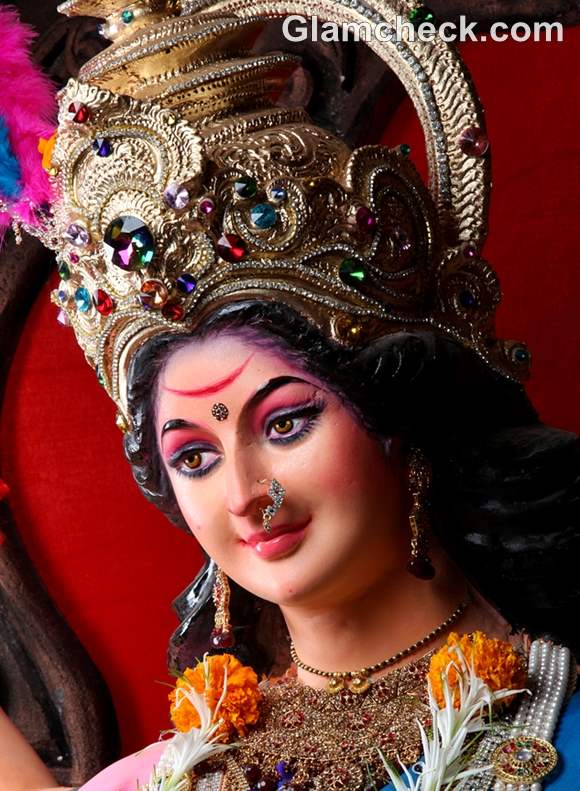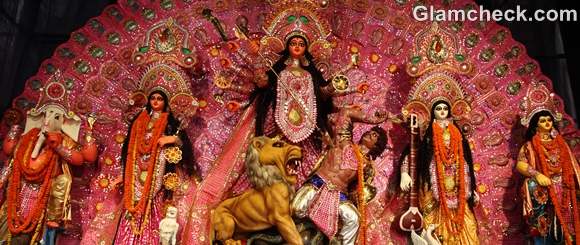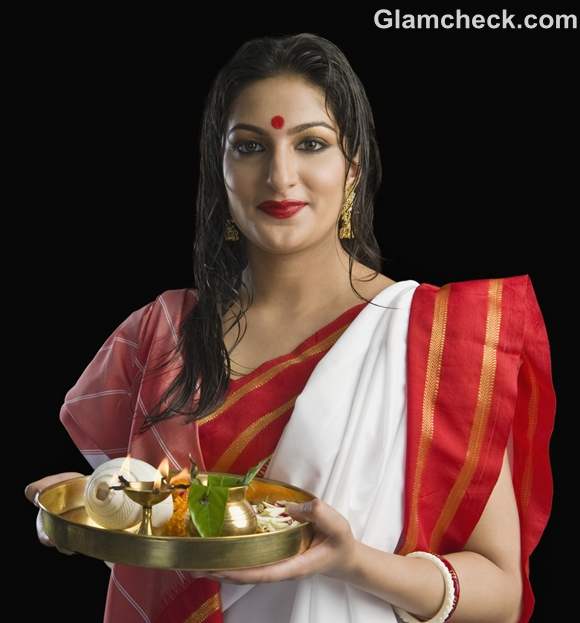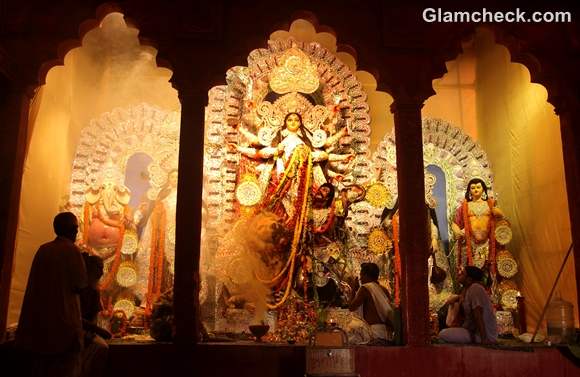The lunar month of Ashwin(usually September/ October) sees the most pious period of nine days, Navratri.
Navratri and Durga Puja dates in 2013: October 5-13
Navratri and Durga Puja dates in 2012: October 16 to 24.
The Navratri, literally meaning nine days are devoted to the worship of the three mother Goddesses – Durga, Lakshmi and Saraswati. Goddess Durga is the Goddess of valour, power and energy, Goddess Lakshmi, the one who bestows money and prosperity, Goddess Saraswati is known to shower knowledge and spiritual guidance.
 Navratri Durga Puja 2012
Navratri Durga Puja 2012
Durga puja is celebrated on Mahalaya ( the 5th day), 6th day( Shasthi), the 7th ( Saptami), the 8th( Ashtami) and the 9th( Navami). On the tenth day (Mahadashmi) Dussehra is celebrated; which is to mark the victory of good over evil, right over wrong.
The Navratri and Durga puja are celebrated in all parts of India and are also the longest Indian festival and are usually marked by worship, fun and fasting
History of the Navratri and Durga Puja
 Durga Puja 2012 Navratri
Durga Puja 2012 Navratri
There are a few legends as to why the Navratri and Durga Puja are celebrated, the reason why Goddess Durga is worshipped.
- Perhaps the most prevalent legend is that this period marks the nine day long duel between the all powerful demon Mahisasur and the goddess of valour Goddess Durga. On the ninth night of the duel, the demon was killed by goddess Durga, making way for celebrations on the tenth day – Dussehra .
- Another popular folk lore is how during these nine days or the Navratri, lord Rama prayed to Goddess Durga and her various forms for strength and power to defeat and kill Ravana, the demon king who had stolen Lord Rama’s wife Sita. On the tenth day, that is Dussehra, he killed Ravana and that is why the day is celebrated to be victory of good over evil. For this reason, it is common to have Ramlila shows( depicting the battle of Ram with Ravana) during the Navratras.
- Durga Puja is also said to commemorate the annual visit of Ma Durga with her children to her parents’ home and being immersed in water on the 10th day to reunite her with Shiva.
Traditional wear, rituals and celebrations during the Navratri and Durga Puja
From times immemorial, the Hindus celebrate the Navratri and Durga Puja with much fanfare and treat this as a time to meet and greet, fast and feast with their families, friends and relatives.
No wonder then, these festivals are the perfect time to dress up in all your traditional wear. Every part of the country celebrates the festival of Navratri and Durga Puja in their own unique way.
Western states of Gujarat and Maharashtra see the women folk wear traditional ghaghra-choli during the Navratri as they indulge in the traditional group dance forms of ‘Dandiya’ and ‘Garbha’. It is common to wear backless blouses, studded with mirror work and matching ear rings and jewellery. Traditional delicacies are made during this period and visits to relatives, family and friends are the order of the day.
 Durga Puja Bengali Woman
Durga Puja Bengali Woman
Saris with broad borders are very common in Western part of the country where the Durga Puja is celebrated with much fervour and zeal and feasting and visiting the various community Puja pandals or podiums to seek the divine blessings of Ma Durga is common. Women adorn their hair with flowers and wear beautiful jewellery. Offering flowers during the morning hours, distribution of bhog or ma’s blessed food during noon and cultural festivities in the evenings are common during the Durga Puja festival.
The northern Indian states treat this as a time to observe fasts, avoid non vegetarian food and pay obeisance to the Goddess. It is common to have the Kanya Puja on the ninth day or Mahanavmi in the North. On this day, nine small girls representing the nine forms of Goddess Durga are invited, fed and given gifts. It is common to wear traditional dresses such as saris and salwar suits.
The southern states also celebrate the Navratri and Dussehra festival with great zeal and fervour and grand processions are taken out and traditional delicacies made. Women wear their beautiful saris and Ghaghara and are decked with flowers and jewellery.
Durga Puja pandals or podiums
 Durga Puja pandals 2012 podiums
Durga Puja pandals 2012 podiums
The eastern state of West Bengal and Tripura celebrate the biggest socio cultural event for the Bengali community – Durga Puja with great zeal. The cities of these two states are dotted with special pandals or temporary bamboo and cloth structures created by master craftsmen to house the idols of the Gods and Goddesses. Detailed planning is undertaken months before the actual festival for creating these pandals and sourcing the idols. Apart from the three mother Goddess who are housed in the pandals, lord Ganesh and Kartikey( sons of Goddess Durga ) and lord Shiva( Mother Durga’s consort) occupy a place of prominence on all Durga Puja podiums that are constructed. On the 10th day, the idols of all Gods are immersed in water, to bid adieu to the Goddess and is symbolic of the goddess going to meet her husband Shiva in the Himalayas.
The funds for creation of these podiums are usually collected from the community and corporate sponsorships. The pandals could be theme based such as nature or Taj mahal or may be inspired by something more exotic such as Egyptian civilization. Sometimes even a popular film can be an inspiration for the pandals. Often there is competition held to judge the best and most creative pandals during Durga pujas. It is common place to visit as many pandals as you can and enjoy yourself with friends and family during this period.
India is known as the land of festivals and the Navratri and Durga Puja mark just the beginning of many other festivals such as the Karwa Chauth, diwali and Christmas which follow soon after.
Shutterstock, Indian Photo Agency
